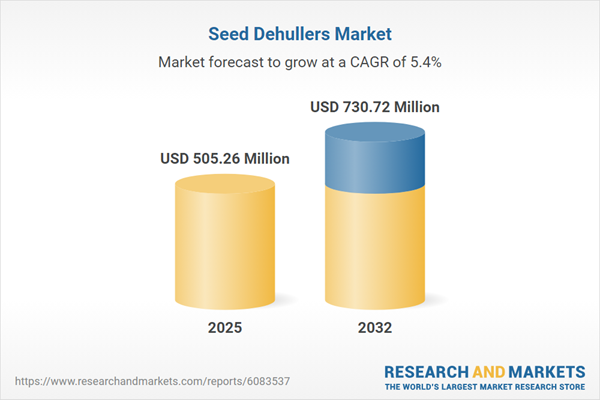Speak directly to the analyst to clarify any post sales queries you may have.
As global agriculture expands to meet new quality standards and operational demands, the seed dehullers market is increasingly central to achieving greater crop value, nutritional enhancement, and production efficiency. Strategic advances in technology, sourcing, and applications are fueling its transformation across a diverse set of regions and industry verticals.
Market Snapshot: Seed Dehullers Market Growth and Outlook
The seed dehullers market grew from USD 480.84 million in 2024 to USD 505.26 million in 2025. Sustained by increasing automation and optimized processing capabilities, the industry is projected to reach USD 730.72 million by 2032, registering a CAGR of 5.37%. Demand is driven by adoption of advanced dehulling solutions that support both industrial-scale food processing and specialized agricultural segments. These shifts reflect a strong global appetite for higher product consistency and improved operational performance.
Scope & Segmentation: Comprehensive Market Coverage
This research report provides detailed analysis across multiple dimensions of the seed dehulling market, structured as follows:
- Machine Types: Centrifugal dehullers, disc dehullers, impact dehullers, rolling dehullers
- Key Components: Dehulling unit, electric motor, grain collecting tray, hopper
- Operation Type: Automatic and manual systems with varying workforce and investment requirements
- Seed Categories: Cereals, grains and pulses, nuts, oilseeds—each presenting unique process needs
- Sales Channels: Offline retail and online retail, facilitating access to machines and service packages
- Applications: Agriculture, animal feed, food processing, and nutraceuticals benefit from tailored equipment solutions
- End-User Groups: Agritechnology firms and food processing businesses are the main operators of seed dehulling technology
- Geographic Regions: Coverage includes the Americas (United States, Canada, Mexico, Brazil, Argentina, Chile, Colombia, Peru), Europe, the Middle East & Africa (including the UK, Germany, France, Russia, Italy, Spain, Netherlands, Sweden, Poland, Switzerland, UAE, Saudi Arabia, Qatar, Turkey, Israel, South Africa, Nigeria, Egypt, Kenya), and Asia-Pacific (China, India, Japan, Australia, South Korea, Indonesia, Thailand, Malaysia, Singapore, Taiwan)
- Leading Companies: Examined companies include Ag Growth International, Akyurek Technology, Bühler AG, Satake Corporation, and additional global and regional manufacturers
Key Takeaways: Strategic Insights in the Seed Dehullers Market
- Emergence of digital controls, automation, and sensor-driven feedback are minimizing kernel damage and maximizing output quality in advanced dehulling systems.
- Manufacturers are prioritizing modular and scalable equipment, supporting seamless capacity upgrades and retrofit options in response to evolving plant requirements.
- There is growing deployment of energy-efficient designs and precision-engineered materials, resulting in extended machine life and reduced maintenance overhead.
- Opportunities are expanding as demand increases for specialty food and high-protein markets, driving the need for customized dehulling profiles and adaptable machine configurations.
- Integrated service offerings, including predictive maintenance and remote diagnostics, are strengthening vendor-client relationships and reducing unplanned disruptions.
Tariff Impact: Navigating Market Complexity and Supply Chain Shifts
United States tariff adjustments in 2025 have added cost pressures for importers of dehulling equipment, sparking realignment of procurement strategies and regional investments. OEMs have responded by localizing production and expanding assembly hubs to limit exposure to duties. The consequences include fluctuating lead times, shifts to domestic and regionally sourced machinery, and greater reliance on diversified supplier networks to ensure smooth operations across borders.
Primary Keyword Focus: Seed Dehullers Market Leadership
Technology adoption within the seed dehullers market is redefining value for producers, processors, and equipment suppliers alike. The integration of data analytics, new manufacturing techniques, and sustainability-focused design is enabling more agile, resilient supply chains and operations. These shifts empower organizations to enhance output quality and reduce risks in both established and emerging regional markets.
Methodology & Data Sources
This analysis is grounded in qualitative interviews with industry executives and hands-on evaluation of processing facilities. Supplementary secondary research draws on trade publications, regulatory documents, patented technologies, and authoritative statistical databases. Structured analytical frameworks and peer-review protocols support the report’s rigor and reliability.
Why This Report Matters
- Delivers actionable insights on technology adoption, cost management, and supply chain resilience for C-suite decision-making.
- Equips stakeholders to benchmark against competitors, evaluate new market opportunities, and mitigate procurement risks.
- Supports strategic planning for investment, partnership, and innovation across the full seed dehulling value chain.
Conclusion
Dynamic innovation, regulatory shifts, and granular market analysis are shaping the next phase for seed dehulling technologies. This report presents an indispensable resource for informed, confident decision-making in today's evolving agricultural landscape.
Table of Contents
3. Executive Summary
4. Market Overview
7. Cumulative Impact of Artificial Intelligence 2025
Companies Mentioned
The companies profiled in this Seed Dehullers market report include:- Ag Growth International Inc.
- Akyurek Technology
- Alvan Blanch Development Company Ltd.
- Anyang Best Complete Machinery Engineering Co., Ltd
- Avity Agrotech Private Limited
- Bühler AG
- Codema LLC
- Farmet a. s.
- Goldin India Equipments Private Limited
- Hebei Maoheng Machinery Co., Ltd.
- Henan Kingman M&E Complete Plant Co., Ltd
- JK Machinery a.s.
- Krishna Industries
- Ocrim S.p.A.
- Raj Food Processing
- Satake Corporation
- Sifter International
- V Tech Engineering
- Zhengzhou LONGER Machinery Co., Ltd.
Table Information
| Report Attribute | Details |
|---|---|
| No. of Pages | 195 |
| Published | November 2025 |
| Forecast Period | 2025 - 2032 |
| Estimated Market Value ( USD | $ 505.26 Million |
| Forecasted Market Value ( USD | $ 730.72 Million |
| Compound Annual Growth Rate | 5.3% |
| Regions Covered | Global |
| No. of Companies Mentioned | 20 |








